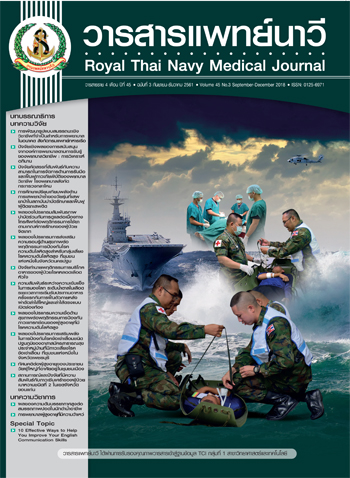การศึกษาเปรียบเทียบพลังต้านการเสพยาบ้าซ้ำของวัยรุ่นที่เสพยาบ้าในสถาบันบำบัดรักษาและฟื้นฟูผู้ติดยาเสพติด
Main Article Content
บทคัดย่อ
การวิจัยนี้มีวัตถุประสงค์เพื่อ 1) ศึกษาการรับรู้พลังต้านการเสพยาบ้าซ้ำของวัยรุ่นที่เสพยาบ้า 2) เปรียบเทียบการรับรู้พลังต้านการเสพยาบ้าซ้ำของวัยรุ่นที่เสพยาบ้าระหว่างกลุ่มสมัครใจกับกลุ่มบังคับบำบัด และ 3) เปรียบเทียบการรับรู้พลังต้านการเสพยาบ้าซ้ำของวัยรุ่นที่เสพยาบ้าระหว่างกลุ่มที่มีความรุนแรงของการเสพยาบ้าที่แตกต่างกัน โดยพัฒนาแบบประเมินพลังต้านการเสพยาบ้าซ้ำของวัยรุ่นไทยจากแนวคิดพลังต้านการเสพสารเสพติด นำมาสร้างแนวคำถามเพื่อเก็บข้อมูลเชิงคุณภาพในบริบทของวัยรุ่นไทยที่เสพยาแล้วพัฒนาเป็นแบบประเมินที่ประกอบด้วย 6 องค์ประกอบของความสามารถในการต่อต้านการใช้ยาบ้าซ้ำ มีค่าความเที่ยงสัมประสิทธิ์แอลฟาของครอนบาค เท่ากับ 0.97 เก็บข้อมูลในวัยรุ่นที่เสพยาบ้าอายุระหว่าง 12 - 24 ปี ที่เข้ารับการบำบัดในสถาบันบำบัดรักษาและฟื้นฟูผู้ติดยาเสพติดแห่งชาติบรมราชชนนี (โรงพยาบาลธัญญารักษ์) 4 แห่ง ได้แก่ ปทุมธานี ขอนแก่น สงขลา และเชียงใหม่ จำนวน 366 คน เครื่องมือการวิจัย ประกอบด้วย 1) แบบสอบถามข้อมูลส่วนบุคคล 2) แบบประเมินพลังต้านการเสพยาบ้าซ้ำของวัยรุ่นไทย และ 3) แบบสอบถามความรุนแรงของการใช้ยาบ้า วิเคราะห์ข้อมูลโดยการแจกแจงความถี่ ร้อยละ ค่าเฉลี่ย ส่วนเบี่ยงเบนมาตรฐาน และเปรียบเทียบพลังต้านการเสพยาบ้าซ้ำของวัยรุ่นที่เสพยาบ้าด้วยสถิติ Independent t-test, One Way ANOVA และ Post hoc analysis
ผลการวิจัย พบว่า
1. วัยรุ่นที่เสพยาบ้าเข้ารับการบำบัดในระบบสมัครใจ ร้อยละ 55.2 และเข้ารับการบำบัดในระบบบังคับบำบัด ร้อยละ 44.8
2. การรับรู้พลังต้านการเสพยาบ้าซ้ำของวัยรุ่นที่เสพยาบ้าอยู่ในระดับมาก ร้อยละ 48.9 รองลงมาคือ ระดับมากที่สุด ร้อยละ 40.7 ระดับปานกลาง ร้อยละ 9.6 และระดับน้อยถึงน้อยที่สุด ร้อยละ 0.8
3. เปรียบเทียบการรับรู้พลังต้านการเสพยาบ้าซ้ำของวัยรุ่นระหว่างกลุ่มสมัครใจกับกลุ่มบังคับบำบัด พบว่า กลุ่มที่เข้ารับการบำบัดแบบสมัครใจมีคะแนนเฉลี่ยพลังต้านการเสพยาบ้าซ้ำ (X̅ = 170.69) สูงกว่ากลุ่มที่เข้ารับการบำบัดในระบบบังคับบำบัด (X̅ = 164.30) อย่างมีนัยสำคัญทางสถิติ (t = 2.67; p < .05)
4. คะแนนการรับรู้พลังต้านการเสพยาบ้าซ้ำของวัยรุ่นกลุ่มที่อยู่ในระยะยังคงเสพยาบ้าจะมีพลังต้านการเสพยาบ้าซ้ำสูงกว่ากลุ่มที่อยู่ในระยะหมกมุ่นกับการเสพยาบ้า (X̅ = 169.75 และ X̅ = 164.07 ตามลำดับ) และเมื่อเปรียบเทียบกลุ่มตัวอย่างที่มีการรับรู้ความรุนแรงของการเสพยาบ้าแตกต่างกันจะมีคะแนนพลังต้านการเสพยาบ้าซ้ำแตกต่างกันอย่างมีนัยสำคัญทางสถิติ (F = 2.822, p-value < .05) โดยกลุ่มที่แตกต่างกัน คือ กลุ่มรับรู้ความรุนแรงของการเสพยาบ้าระยะยังคงเสพยาบ้ากับระยะหมกมุ่นกับการ
เสพยาบ้า (Sig = .034, p-value < .05)
Article Details

อนุญาตภายใต้เงื่อนไข Creative Commons Attribution-NonCommercial-NoDerivatives 4.0 International License.
เอกสารอ้างอิง
ศูนย์อำนวยการและป้องกันยาเสพติดแห่งชาติ. แผนป้องกันและแก้ไขปัญหายาเสพติดเร่งด่วน ปี 2561. [อินเทอร์เน็ต]. [เข้าถึงเมื่อ 22 มิถุนายน 2561]. แหล่งที่มา: https://www.ppb.moi.go.th/midev03/upload/ppb2561.pdf
สำนักบริหารการสาธารณสุข สำนักปลัดกระทรวงสาธารณสุข. ระบบรายงาน ระบบติดตามและเฝ้าระวังปัญหายาเสพติด (บสต. 1-5). [อินเทอร์เน็ต]. [เข้าถึงเมื่อ 22 มิถุนายน 2561]. แหล่งที่มา: https://antidrug.moph.go.th
กรมสุขภาพจิต. เวชสถิติผู้ป่วยในบำบัดสุราและสารเสพติดแบบประเมินทางสังคม. [อินเทอร์เน็ต]. [เข้าถึงเมื่อ 27 มีนาคม 2561]. แหล่งที่มา: https://www.dmh.go.th/abstract/nurse/details.2508
Calipari ES, Ferris MJ. Amphetamine mechanisms and actions at the dopamine terminal revisited. [Internet]. [cited 2017 May 24]. Available from: https://www.ncbi.nlm.nih.gov/pmc/articles/PMC3753078/pdf/nihms492057.pdf.
Nilaban S, Sriherun B, Kongthong U. Causal relationship of factors relapsing behavior of methamphetamine users. Journal of Graduate Studies Valaya Alongkron Rajabhat University 2016; 10(1): 193-207. (in Thai).
สถาบันธัญญารักษ์. จำนวนและร้อยละการบำบัดซ้ำในปีงบประมาณ 2560. [อินเทอร์เน็ต]. [เข้าถึงเมื่อ 6 มกราคม 2561]. แหล่งที่มา: www.thanyarak.go.th/thai/index.php?option.
Office of the Narcotics Control Board, United Nations Office on Drugs and Crime. World drug report. [Internet]. [cited 2018 December 28]. Available from: https://information.oncb.go.th.
Marlatt GA, Gordon JR. Relapse prevention: maintenance strategies in the treatment of addictive behaviors. New York: Guilford press; 1985.
Chaipichitpan N. A study of factors affecting amphetamine relapsing behavior of secondary school students treated in Thanyarak Hospital. [Master’s Thesis, Faculty of Educaion]. Chulalongkorn University. 1998. (in Thai).
Suwannanon A, Bannatham R, Chotnipat W, Nooplab S. Personal factors related to be relapse. Bangkok : Drug Users Office of the Narcotics Control Board; 2007. (in Thai).
Thatsananchalee P. The process of non becoming amphetamine addict: a case study of rehabilitated person in process of correctional system. Interdisciplinary Sripatum Chonburi Journal 2011;1(3):36-48. (in Thai).
Hawkins JD, Catalano RF, Miller JY. Risk and protective factors for alcohol and other drug problems in adolescence and early adulthood: implications for substance abuse prevention. Psychol Bull 1992;112(1):64-105.
Braverman MT. Research on resilience and its implications for tobacco prevention. Nicotine Tob Res 1999;1 Suppl 1:S67-72.
Meschke LL, Patterson JM. Resilience as a theoretical basis for substance abuse prevention. The Journal of Primary Prevention 2003;23(4):483-514.
Dillon L, Chivite-Matthews N , Grewa I, Brown R , Webster S, Weddell E, et al. Risk, protective factors and resilience to drug use: identifying resilient young people and learning from their experiences. National centre for Social Research; 2007.
Luthar SS, Cicchetti D, Becker B. The construct of resilience: a critical evaluation and guidelines for future work. Child Dev 2000;71(3):543–62.
Fraser MW, Kirby LD, Smokowski PR. Risk and resilience in childhood. In Fraser MW, editor. Risk and resilience in childhood: an ecological perspective. Washington D.C.: National Association of Social Workers. 2004. p. 13-66.
Costello AB, Osborne JW. Best practices in exploratory factor analysis: four recommendations for getting the most from your analysis. Practical Assessment Research & Evaluation 2005;10(7):1-9.
สถาบันธัญญารักษ์. คู่มือการบำบัดรักษาผู้ติดยาเสพติด. กรุงเทพมหานคร: องค์การสงเคราะห์ทหารผ่านศึก; 2546.
Benard B. Fostering resiliency in kids: protective factors in the family, school and community. Portland, OR: Northwest Regional Educational Laboratory; 1991.
Ryan RM, Deci EL. Self-determination theory and the facilitation of intrinsic motivation, social development, and well-being. Am Psychol 2000;55(1):68-78.
Panchabuse C. Saengduenchai S. The effectiveness of cognitive-behavioral therapy program on early relapse prevention among methamphetamine-dependent patients. Journal of Nursing Division 2013;40(1):24-38. (in Thai).
Netnualyai R, Nitchanet C, Bhukong S, Boonyapithak S, Phukao D. Thai youth’s voluntary applications of drug treatment. Journal of Association of Researchers 2014;19(2):36-44. (in Thai).
Pattrakorn A, Chaipichitpan N. The effect of FAST model for addiction patient in Thanyarak Institute. J Psychiatr Assoc Thailand 2015;60(1):71-81. (in Thai).
Jitpong W. Severity of relapse to methamphetamine dependence in patients with history of substance-dependency treatment at the inpatient department, Thanyarak Institute on drug abuse. [Master’s Thesis, Faculty of Medicine]. Chulalongkorn University. 2009. (in Thai).

